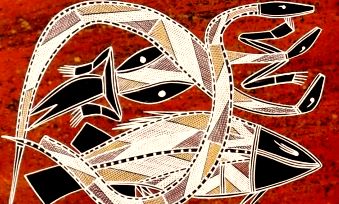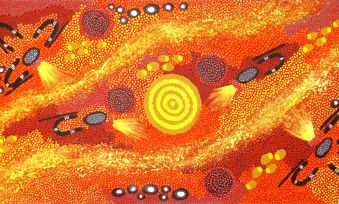Australian Aboriginal Art
In the Central desert areas of Australia the Aboriginal people have their own ceremonies in which a series of song and dance cycles tell of the Ancestral Beings who walked the earth teaching women's law and ceremony to isolated groups living throughout the desert. Each tribe has its own set of ancestors with different stories, designs and dances, but most of the ceremonies have one theme common to all groups - that of food gathering as the most important part of their lives. During the ceremonies they will paint their bodies and breasts in various designs which represent the particular ceremony being performed. Mostly these are curved or straight lines, including circles and squares. The abstract figures or iconography they depict tell stories of the dreamtime, which have been handed down for thousands of years through song and dance ceremonies. A 'U' shape represents a person or groups of people sitting down with crossed legs. A larger 'U' indicates a windbreak. Concentric circles can represent a campsite, stone, waterhole or fire. The exact imprint of human feet or animal paws depicts tracks of humans, emus, possums, kangaroos etc. In their paintings they depict the implements they use, including digging sticks, grinding stones, nulla nullas, spears, boomerangs and coolamons for carrying.
In the Northern parts of Australia many paintings are done on bark. The bark used is from the stringy bark tree (Eucalyptus tetrodonta). It must be knot free without splits or termite damage and can only be removed from the trees from the wet season until the middle of the dry season. The painter cuts through the bark and tears off a rectangular piece. When first removed, the bark is rough and curled to the shape of the tree and must therefore be smoothed and flattened. Over a number of days the bark is saturated with water and weighted down with stones to gradually uncurl and straighten the bark out. Once it is flat it is then cured in the heat of the fire. The bark painters of Arnhemland work from a limited palette, rarely using more than the 4 basic colours: red, black, yellow and white, although sometimes the primary colours are mixed to give a pink, orange or grey. Red and yellows come from a variety of ochres including hematite, ironstone and limonite. White is generally gypsum or pipeclay and black is made from manganese ore or charcoal. The pigments are ground finely and mixed with water and vegetable fixatives. The most common natural fixative is the gum or resin from various local trees however the artists now more often use a commercial glue.


